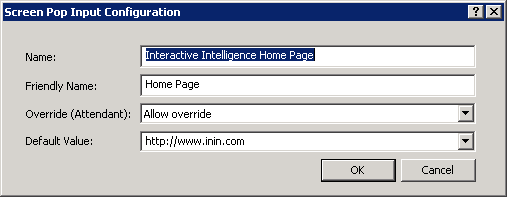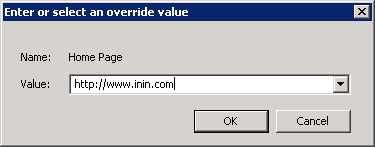- Contents
Interaction Attendant Help
 Screen Pop
Screen Pop
Screen Pop executes an action previously configured using the Actions container in Interaction Administrator. Actions can be thought of as a direct communications link between two application programs. Data is passed to a third party application to perform some action. For example, a URL can be passed to a web browser.
Three types of screen pop actions can be defined in Interaction Administrator: DDE, Web Browser Screen Pop, and Custom Screen Pop. Web Browser Screen Pop uses the same internal configuration as a custom screen pop, but has a separate configuration dialog for easy configuration.
In addition, scripts created in RightNow's ScriptAssist appear as actions in Interaction Administrator's Actions container. When a ScriptAssist script is saved, it appears in Interaction Administrator's Actions container, and the script is also visible to Screen Pop nodes in Interaction Attendant.
Note—Interaction Attendant does not support DDE actions.
Once actions are defined in Interaction Administrator or optionally in ScriptAssist, an Attendant profile can be set up to call a screen pop action. The default values for the selected screen pop can be overridden to pass different values to the application. For example, you might change the URL of a Web Browser Screen Pop action selected in Attendant, to open a different web page. Override is allowed if the action is configured in Interaction Administrator to allow values to be changed in Attendant.
The Interaction Administrator Help explains how to define actions. This topic explains how to invoke an action from Attendant.
Node Characteristics frame
Options in this frame name the node, assign the digit used to select it, and establish whether or not it is active, used by default, logged, or tracked for reporting purposes.

Name field
The label you enter here becomes the name of the node in the tree structure.
Digit list box
Use this list to select the key that callers press to enter a caller data entry operation. When you assign a digit, the list displays only available digits—those that are not already in use at this level of the tree. If no digit is assigned, callers cannot invoke the operation directly. It is possible to create menu options that are invoked by a routing process, rather than by a user selection. For details, see invoke a menu operation automatically.
Active check box
By default, forms are "on", or "active", which means that Interaction Attendant will process them. If you uncheck a form's Active check box, the name of the node turns gray in the tree to indicate that the form is inactive. Interaction Attendant and its handlers will thereafter ignore the form and its children. Use this feature to save a configuration that you are testing. Inactive forms are invisible to callers. When a node is inactive, it appears grayed out in the tree view.
Default Action check box
At any given "level" in the tree structure, one node can be marked as the default action. The operation defined by the default node is performed if the caller does not press a key within the timeout period specified by that menu. The icon for default forms has a green border in the tree structure. Any node below a menu or schedule can be marked as the default action, by checking the form's default action check box.
Enable IVR Reporting
This option determines whether or not reporting data will be collected when control passes through this node. Several IVR Reports summarize this information. IVR Reporting is disabled by default. Enable it to capture the date, time and duration of time that the call remained in the node and its children. This option is hidden when Attendant is connected to a server that does not have reporting installed. For more information about this feature, see IVR Reporting Option.
Add entry to the Interaction Log
When this option is enabled, information about this node is appended to the call's Interaction Log when the call enters this node. This helps track the path that a call took through Attendant. The Interaction Log is maintained for reporting purposes. See View the Interaction Log for details.
Configure Speech Recognition... button
Select this button to configure words or phrases that can be associated with menu options. Callers can verbally indicate the options they want in the IVR instead of pressing a digit on the phone. You can enter multiple words and phrases for each menu item, just as callers may phrase the same request in different ways. For example, "transfer funds" or "funds transfer". See Add Speech Recognition keywords or phrases to Inbound Call Operations.
Screen Pop Action and Values

Screen Pop Action
Screen Pop Action lists entries from the Actions container in Interaction Administrator. Since Interaction Attendant does not support DDE actions, those are not displayed in this list. If you add or update Actions in Interaction Administrator while using Interaction Attendant, you must restart Interaction Attendant to view changes.
Name/Value pairs
This list is populated if the action selected in the Screen Pop Action drop list contains input values to pass to the application popped. Depending upon the override settings set for the Action in Interaction Administrator, you can edit these values by typing in different values or select a predefined multiple-choice value.
For example, you might change the URL of a Web Screen Pop action to specify a different page, or change the value of parameters used by script actions.
Edit button
Opens the selected Name/Value pair so that you can edit or select the value passed to the application.

If in Interaction Administrator, Allow override with selected values (Multiple Choice) was selected when the value was defined (as shown above) then you can select one value to pass to the application after clicking Edit in Interaction Attendant:

Conversely, if Allow Override was selected when the entry was defined in Interaction Administrator, you can edit the entry by typing a new value manually. The image below shows a value that can be manually overridden in Attendant:

When Edit is clicked, the dialog allows a new entry to be typed:

Tip: To set the URL parameter to the value of a custom call attribute, type $(attr_name) in the Value field, after replacing attr_name with the value of the custom call attribute. This allows the parameter to be populated with a call attribute set earlier in the Attendant flow.
For overridable or static input values, static items can be selected from the drop list in Attendant:

These pass dynamic information to the application popped instead of a predefined string value.
Action When Finished

Sets the finishing path to take when this node executes successfully.
Reset button
For the selected action, resets any override value to the default value of the action.
Reset All button
For all listed actions, resets any overridden value to default values.
Go back to previous menu
This option sets up a simple loop that "reruns" the menu from the top.
Disconnect
This option disconnects the call when the operation is completed successfully.
Transfer to Operator Processing
Transfers the call for evaluation by operator profiles defined for this server.
Jump to a custom location
This option allows you to jump to any profile, schedule, menu, or operation that is defined for the current server.



